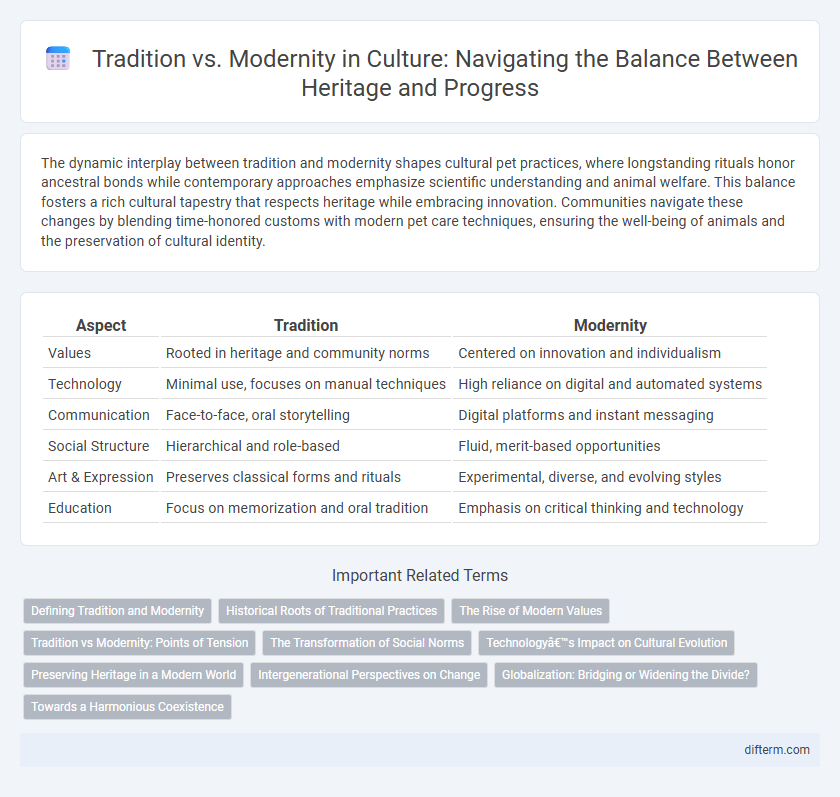The dynamic interplay between tradition and modernity shapes cultural pet practices, where longstanding rituals honor ancestral bonds while contemporary approaches emphasize scientific understanding and animal welfare. This balance fosters a rich cultural tapestry that respects heritage while embracing innovation. Communities navigate these changes by blending time-honored customs with modern pet care techniques, ensuring the well-being of animals and the preservation of cultural identity.
Table of Comparison
| Aspect | Tradition | Modernity |
|---|---|---|
| Values | Rooted in heritage and community norms | Centered on innovation and individualism |
| Technology | Minimal use, focuses on manual techniques | High reliance on digital and automated systems |
| Communication | Face-to-face, oral storytelling | Digital platforms and instant messaging |
| Social Structure | Hierarchical and role-based | Fluid, merit-based opportunities |
| Art & Expression | Preserves classical forms and rituals | Experimental, diverse, and evolving styles |
| Education | Focus on memorization and oral tradition | Emphasis on critical thinking and technology |
Defining Tradition and Modernity
Tradition encompasses the inherited customs, beliefs, and practices passed down through generations, shaping cultural identity and social cohesion. Modernity emphasizes innovation, technological advancement, and progressive thinking that challenge conventional norms and create new societal paradigms. The dynamic interplay between tradition and modernity influences cultural evolution, balancing preservation with adaptation.
Historical Roots of Traditional Practices
Traditional practices often stem from deep historical roots embedded in ancient customs, rituals, and societal values passed down through generations. These practices reflect the collective identity and heritage of communities, preserving language, art forms, and ceremonies linked to specific historical periods. Despite the influence of modernity, the historical significance of tradition maintains cultural continuity and offers insight into ancestral knowledge and worldview.
The Rise of Modern Values
The rise of modern values has reshaped cultural landscapes by prioritizing individualism, equality, and technological innovation over traditional customs. This shift has fostered progressive social norms and expanded opportunities for diverse expressions of identity. As societies adapt, the balance between preserving heritage and embracing change continues to redefine cultural evolution.
Tradition vs Modernity: Points of Tension
Tradition often emphasizes preserving cultural heritage, rituals, and established social norms, fostering a sense of identity and continuity. Modernity challenges these structures through innovation, individualism, and rapidly evolving technologies, creating friction in communities adjusting to change. The tension between tradition and modernity shapes cultural dynamics, influencing social values, behaviors, and collective memory.
The Transformation of Social Norms
The transformation of social norms reflects the dynamic interplay between tradition and modernity, where longstanding cultural practices evolve to accommodate contemporary values and technological advancements. Communities increasingly reinterpret rituals, gender roles, and family structures, blending inherited heritage with progressive ideals to foster inclusivity and innovation. This cultural shift underscores a redefinition of identity and social cohesion in an era of globalization and digital connectivity.
Technology’s Impact on Cultural Evolution
Technology accelerates cultural evolution by reshaping traditional practices through digital communication, virtual reality, and social media platforms. Innovations like AI and augmented reality facilitate new expressions of cultural identity while challenging the preservation of indigenous customs. The dynamic interplay between technological advancements and cultural heritage fosters continuous transformation in societal values and collective memory.
Preserving Heritage in a Modern World
Preserving heritage in a modern world requires integrating traditional cultural practices with contemporary innovations to maintain identity while embracing progress. Efforts such as digitizing historical archives, promoting indigenous languages through social media, and supporting artisanal crafts help safeguard intangible cultural assets amid rapid globalization. Balancing global connectivity with respect for ancestral customs ensures cultural continuity and enriches societal diversity.
Intergenerational Perspectives on Change
Intergenerational perspectives reveal how traditions are both preserved and transformed as younger generations reinterpret cultural practices through a modern lens. Elders often serve as custodians of heritage, emphasizing continuity, while youth prioritize innovation and adaptability, reflecting evolving social values. This dynamic interplay shapes cultural identity, balancing respect for ancestral customs with the demands of contemporary life.
Globalization: Bridging or Widening the Divide?
Globalization intricately shapes cultural landscapes by simultaneously bridging traditions and accelerating modernity, fostering cross-cultural exchanges that enhance global understanding. It enables the preservation and revitalization of indigenous practices through digital platforms while introducing homogenizing influences that risk eroding unique cultural identities. The dynamic interplay between tradition and modernity under globalization highlights the critical need for balanced cultural policies that promote diversity without resisting innovation.
Towards a Harmonious Coexistence
Tradition anchors cultural identity through rituals, customs, and values passed down generations, while modernity introduces innovation, technology, and progressive social norms. Balancing respect for heritage with the embrace of contemporary change fosters a dynamic society where cultural continuity and evolution coexist harmoniously. This synthesis strengthens community cohesion, enriching cultural expression and adaptability in a globalized world.
tradition vs modernity Infographic

 difterm.com
difterm.com